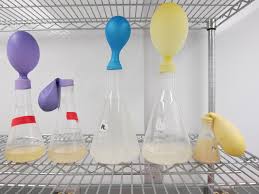Pipetting and Self-inflating Hydrogen Balloons
A chemist set-up two conical flasks A and B and placed the balloon on the top of each flask to be self-inflated by hydrogen gas being produced during the reaction in the flasks. In flask A, chemist reacted 5.10g Magnesium with 0.0447 moles of hydrochloric acid. In flask B, the scientist reacted 24.12 grams of Magnesium with 0.998 moles of hydrochloric acid. Which balloon will inflate the most? Explain your answers in details indicating all the calculations.
To
answer this question, one must determine the amount of hydrogen gas produced in
each flask. The calculations and conclusion are shown below:
Flask A
Molecular
mass of magnesium= 24.30g/mol
Given
mass of magnesium = 5.10g
Molecular
mass of hydrogen gas= 2.02g/mol
5.10g
Mg *(1mole/24.30g)*(1mole H2/1 mole Mg)*(2.02g H2/ 1mole
H2) = 0.42 g H2
Given
HCl= 0.447 mol
0.447
mol HCl *(1 mol H2/2 mol HCl)*(2.02 g H2/1 mol H2) =
0.45g H2
Magnesium
is a limiting reactant. 5.10g of Magnesium reacted with 0.447 moles of HC to
produce 0.42 g H2.
Flask B
Given
mass of magnesium= 24.21g
24.21g
Mg*(1mol/24.30g)*(1mol H2/1 mol Mg)*(2.02g H2/1 mole H2)
= 2.01 g H2
Given
moles of HCl= 0.998 mol
0.998mol
HCl *(1 mol H2/2 mol HCl)*(2.02g H2/1 mol H2)
= 1.008 g H2
The
hydrochloric acid is a limiting reactant.
24.21g of Magnesium reacted with 0.998 mol of HCl to yield 1.008g H2.
The
reaction in flask B produced more hydrogen gas (1.008g) than in flask A, hence,
balloon attached to flask B inflated more.




Comments
Post a Comment